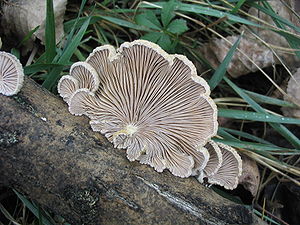Split leaves
| Split leaves | ||||||||||||
|---|---|---|---|---|---|---|---|---|---|---|---|---|

Common split-leaved leaf ( Schizophyllum commune ) |
||||||||||||
| Systematics | ||||||||||||
|
||||||||||||
| Scientific name | ||||||||||||
| Schizophyllum | ||||||||||||
| Fr. |
The split leaves ( Schizophyllum ) are a genus of fungi from the family of the split leaf relatives . They are wood dwellers who live mainly as saprobionts , less often as wound parasites. 5 species have been described worldwide, in Europe only the common split leaf ( Schizophyllum commune ) occurs, but sometimes the poplar bark sponge ( Schizophyllum amplum ) is assigned as the sixth species of the genus.
features
The fruiting bodies of the split-leaved leaves are often more than 1–3 cm, rarely up to 5 cm wide, shell-shaped hats on the side or underside of the substrate. Occasionally the attachment point is narrowed to a stubby stem . The top of the hat is fine to coarse-felted and light gray, in dry conditions it is also colored pure white. The light, flesh-pink colored fruit layer on the underside resembles the lamellae of agaric mushrooms , but differs from them in that the lamellae are split into 2 layers. When dry, the two layers roll up so that the spores are prevented from falling out. In damp weather, however, the two layers lie parallel to each other and the spores can escape. The leathery fruit bodies can survive for several years and dry out several times without being damaged.
ecology
The split leaves live as saprobionts mainly on wood and rarely on other organic substrates . Sometimes they appear as weak parasites .
distribution
The common split leaf is considered to be the most successful large mushroom species. It occurs on all continents except Antarctica. The common beech is mainly used as a substrate, but the fungus also colonizes many other types of wood and other organic materials.
meaning
The fungus causes white rot and can therefore, as a wood decomposer, cause considerable damage, especially to built-up wood.
The mushroom also produces the beta-glucan schizophyllan .
Names
The scientific name is derived from the Greek words "σχίζειν" (s-chizein = to split) and "φύλλον" (phyllon = leaf) and, like the German name, refers to the split lamellae.
literature
- German Josef Krieglsteiner (Ed.): The large mushrooms of Baden-Württemberg . Volume 1: General Part. Stand mushrooms: jelly, bark, prick and pore mushrooms. Ulmer, Stuttgart 2000, ISBN 3-8001-3528-0 .
- Heinrich Dörfelt , Gottfried Jetschke (Ed.): Dictionary of mycology. 2nd Edition. Spectrum Academic Publishing House, Heidelberg / Berlin 2001, ISBN 3-8274-0920-9 .

